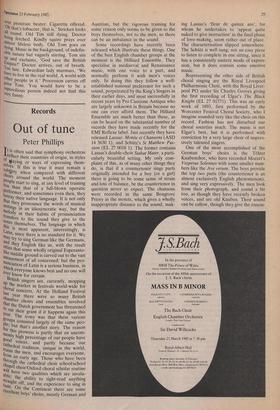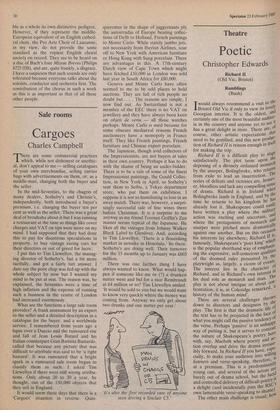Records
Out of tune
Peter Phillips
It is often said that symphony orchestras reflect their countries of origin, in styles of %laying or ways of expressing them- selves. If this is true it must remain a Shogety when compared with different Choirs around the world. The moment Pe, °Ple start to sing, at any level of training less than that of a full-blown operatic
Performer, and sometimes even then, they betra.. „ y their native language. It is not only
that they pronounce the words of musical settings in an idiosyncratic way, but the Melody in their habits of pronunciation transfers to the sound they give to the notes themselves. The language in which tilt is is most apparent, interestingly, is Latin, since there is no standard for it. We may try to sing German like the Germans, and they English like us, with the result often that some wholly original Esperanto- like middle ground is carved out to the vast amusement of all concerned; but the pro- nunciation of Latin is a serious business, in Which everyone knows best and no one will ever know for certain. British singers are, currently, mopping LIP the market in festivals world-wide for choral concerts. At the Holland Festival last year there were so many British chamber choirs and ensembles involved that the Dutch government has threatened to cut their grant if it happens again this Year. The irony was that these various groups consisted largely of the same peo- ple; but that's another story. The reason °I. this prowess is partly that an uncom- monly high percentage of our people have
good voices, and partly because our cathedral tradition, unique in the world, trains the men, and encourages everyone, from an early age. Those who have been through the cathedral choir schooUschool chapel choir/Oxford choral scholar routine will have two qualities which are invalu- able: the ability to sight-read anything
straight off, and the experience to sing in tune. On the Continent there are some excellent boys' choirs, mostly German and
Austrian, but the vigorous training for some reason only seems to be given to the boys themselves, not to the men, so there can be an imbalance in the sound.
Some recordings have recently been released which illustrate these things. One of the best English chamber groups at the moment is the Hilliard Ensemble. They specialise in mediaeval and Renaissance music, with one voice to a part, and normally perform it with men's voices only. In doing this they follow a well- established national preference for such a sound, perpetrated by the King's Singers in their earlier days, and most successfully in recent years by Pro Cantione Antigua who are largely unknown in Britain because no one can ever afford them. The Hilliard Ensemble are much better than these, as can be heard on the substantial number of records they have made recently for the EMI Reflexe label. Just recently they have released Lassus: Motets et Chansons (ASD 14 3630 1), and Schutz's St Matthew Pas- sion (EL 27 0018 1). The former contains Lassus's double-choir Stabat Mater, a parti- cularly beautiful setting. My only com- plaint of this, as of many other things they do, is that if a countertenor sings parts originally intended for a boy (or a girl) there is going to be some sense of strain and loss of balance, be the countertenor in question never so expert. The chansons were recorded in the same Boxgrove Priory as the motets, which gives a wholly inappropriate distance to the sound, mak- ing Lassus's 'fleur de quinze ans', for whom he undertakes to 'appear quite naked to give instruction' in the final phase of love-making, seem rather out of place. The characterisation slipped somewhere. The Schutz is well sung; not an easy piece to listen to complete in one sitting, since it has a consistently austere mode of expres- sion, but it does contain some emotive music.
Representing the other side of British choral singing are the Royal Liverpool Philharmonic Choir, with the Royal Liver- pool PO under Sir Charles Groves giving the first recording of Elgar's The Black Knight (EL 27 01571). This was an early work of 1893, first performed by the Worcester Festival Choral Society, who I imagine sounded very like the choir on this record. Fashion has not disturbed our choral societies much. The music is not Elgar's best, but it is performed with conviction by a very large choir of impres- sively talented singers.
One of the most accomplished of the German boys' choirs is the TOlzer Knabenchor, who have recorded Mozart's Vesperae Solennes with some smaller num- bers like the Ave verum. The boys provide the top two parts (the countertenor is an almost exclusively English phenomenon), and sing very expressively. The men look from their photograph, and sound a bit too, as though they have recently broken voices, and are old Knaben. Their sound can be callow, though they give the ensem- ble as a whole its own distinctive pedigree. However, if they represent the middle- European equivalent of an English cathed- ral choir, the Pro Arte Choir of Lausanne; in my view, do not provide the same standard as the ropiest English choral society on record. They are to be heard on a disc of Bach's four Missae Breves (Philips 6725 038), and are, quite frankly, a disgrace. I have a suspicion that such sounds are only tolerated because everyone talks about the soloists, conductor and orchestra first. The contribution of the chorus in such a work as this is as important as that of all these other people.











































 Previous page
Previous page